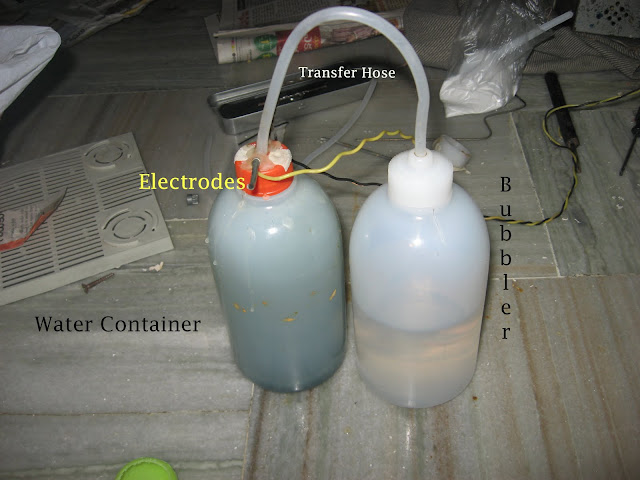The other day i was surfing the net about some alternate fuels. I've come across this term "HHO gas" being used extensively by many of the sites and blogs on alternete fuels. So, i've decided to try this out. Production of HHO gas begins with the age old electrolysis of water.
Electrolysis of water is the decomposition of water (H2O) into oxygen (O2) and hydrogen gas (H2) due to an electric current being passed through the water.
PRINCIPLE:
An electrical power source is connected to two electrodes, or two plates (typically made from some inert metal such as platinum or stainless steel) which are placed in the water. In a properly designed cell, hydrogen will appear at the cathode (the negatively charged electrode, where electrons enter the water), and oxygen will appear at the anode (the positively charged electrode). Assuming ideal faradaic efficiency, the amount of hydrogen generated is twice the number of moles of oxygen, and both are proportional to the total electrical chargeconducted by the solution.
The number of hydrogen molecules produced is thus twice the number of oxygen molecules. Assuming equal temperature and pressure for both gases, the produced hydrogen gas has therefore twice the volume of the produced oxygen gas. The number of electrons pushed through the water is twice the number of generated hydrogen molecules and four times the number of generated oxygen molecules.
Thus, this gas is commonly known as HHO gas.It took me about two days to decide the plan and setup of the experiment for hho gas and Rs.200/-. Well, u can watch for ur self about the exp below:
or
http://www.youtube.com/watch?v=5SGOlukc2Pw
Well, as u have observed, the gas that comes out of the jar is definetly rich in HYDROGEN. This can be used as a substitute for fossil fuels.HHO also known as Oxyhydrogen is a mixture of hydrogen (H2) and oxygen (O2) gases, typically in a 2:1 molar ratio, the same proportion as water. This gaseous mixture is used for torches for the processing of refractory materials and was the first gaseous mixture used for welding. In practice a ratio of 4:1 or 5:1 hydrogen:oxygen is required to avoid an oxidizing flame.
Oxyhydrogen will combust when brought to its autoignition temperature. For a stoichiometric mixture at normal atmospheric pressure, autoignition occurs at about 570 °C (1065 °F).The minimum energy required to ignite such a mixture with a spark is about 20 microjoules. At normal temperature and pressure, oxyhydrogen can burn when it is between about 4% and 95% hydrogen by volume. But,Water electrolysis does not convert 100% of the electrical energy into the chemical energy of hydrogen. The process requires more extreme potentials than what would be expected based on the cell's total reversible reduction potentials. This excess potential accounts for various forms of overpotential by which the extra energy is eventually lost as heat. For a well designed cell the largest overpotential is the reaction overpotential for the four electron oxidation of water to oxygen at the anode. An effective electrocatalyst to facilitate this reaction has not been developed. Platinum alloys are the default state of the art for this oxidation. Developing a cheap effective electrocatalyst for this reaction would be a great advance (see also). In 2008, a group led by Daniel Nocera announced a potentially more efficient catalyst for artificial photosynthesis composed of a cobalt metal, phosphate, and an electrode. Other researchers are pursuing carbon-based catalysts. The reverse reaction, the reduction of oxygen to water, is responsible for the greatest loss of efficiency in fuel cells.
So, lets hope for the very best. Suggestions are welcome on this post. Mail me for any more info.



1 comments:
WAT MATERIALS DID U USE...?? PLEASE TELL ME STEP BY STEP..
Post a Comment